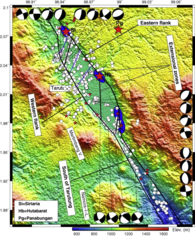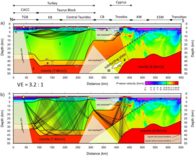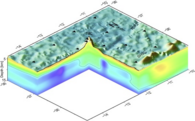We use reflection and refractions seismic methods at different scales as well as earthquake observations and ambient noise to investigate geodynamic key processes. Particularly, we investigate processes at continental shear zones, active and passive continental margins and plumes. For this research we conduct large field experiments.
Shear Zones
Continental shear zones accommodate the relative horizontal motions between continental plates. Prominent examples are the San Andreas fault and the Dead Sea Transform. Earthquakes related to these motions pose a significant threat to the population. Seismic methods provide insight into the deeper structure of the shear zones and their internal architecture.
Projects
Publications
- Fuis, G. S. et al (2017): Subsurface Geometry of the San Andreas Fault in Southern California: Results from the Salton Seismic Imaging Project (SSIP) and Strong Ground Motion Expectations. http://doi.org/10.1785/0120160309
- Braeuer, B., Bauer, K. (2015): A new interpretation of seismic tomography in the southern Dead Sea basin using neural network clustering techniques. http://doi.org/10.1002/2015GL066559
- Braeuer, B. et al (2014): Detailed seismicity analysis revealing the dynamics of the southern Dead Sea area.http://doi.org/10.1007/s10950-014-9441-4
- Muksin, U. et al (2014): Detailed fault structure of the Tarutung Pull-Apart Basin in Sumatra, Indonesia, derived from local earthquake data. http://doi.org/10.1016/j.jseaes.2014.09.009
Konvergente Plattenränder: Subduktionszonen & kontinentale Kollisionen
Convergent margins: Subduction zones and continental collision
At convergent margins two (or more) tectonic plates move against each other. At subduction zones, an oceanic plate thrusts underneath another oceanic or continental plate. The collision of continents often cause the formation of mountain chains and continental plateaus. In any case, the deformation processes active at convergent margins shape the Earth's surface and are also responsible for the most severe earthquakes.
Projects
- AlpArray/SPP 4D-MB, TIPTIMON, CaTeNa, BASE, CoCoCo
Publications
- Feld, C. et al (2017): Crustal structure of the Eratosthenes Seamount, Cyprus and S. Turkey from an amphibian wide-angle seismic profile. http://doi.org/10.1016/j.tecto.2017.02.003
- Kufner, S.-K. et al (2017): Zooming into the Hindu Kush slab break-off: A rare glimpse on the terminal stage of subduction. https://doi.org/10.1016/j.epsl.2016.12.043
- Haberland, C. et al (2017): Architecture and tectono-stratigraphic evolution of the intramontane Baza Basin (Bétics, SE-Spain): Constraints from seismic imaging.http://doi.org/10.1016/j.tecto.2017.03.022
Passive continental margins
A passive continental margin is the transition between oceanic and continental crust which has originally been formed after continental break-up and rifting. Studies at passive margins provide insight into the processes of continental break-up, the onset of the creation of the sea floor and eventually of the mechanisms behind the movement of lithospheric plates.
Projects
- LISP-WAL (SPP-SAMPLE)
Publications
- Ryberg, T. et al (2017): Uppermost mantle and crustal structure at Tristan da Cunha derived from ambient seismic noise. http://doi.org/10.1016/j.epsl.2017.04.049
- Ryberg, T. et al (2017): Upper mantle structure at Walvis Ridge from Pn tomography.http://doi.org/10.1016/j.tecto.2016.08.009
- Ryberg, T. et al (2015): Crustal structure of northwest Namibia: Evidence for plume-rift-continent interaction.http://doi.org/10.1130/G36768.1




